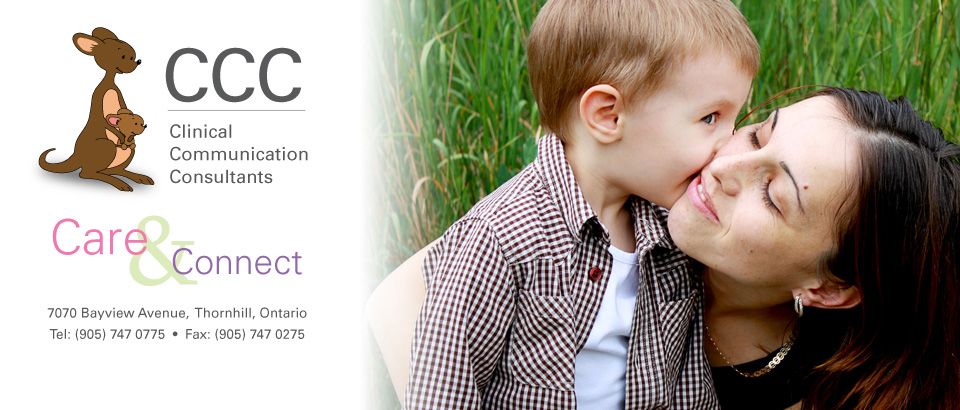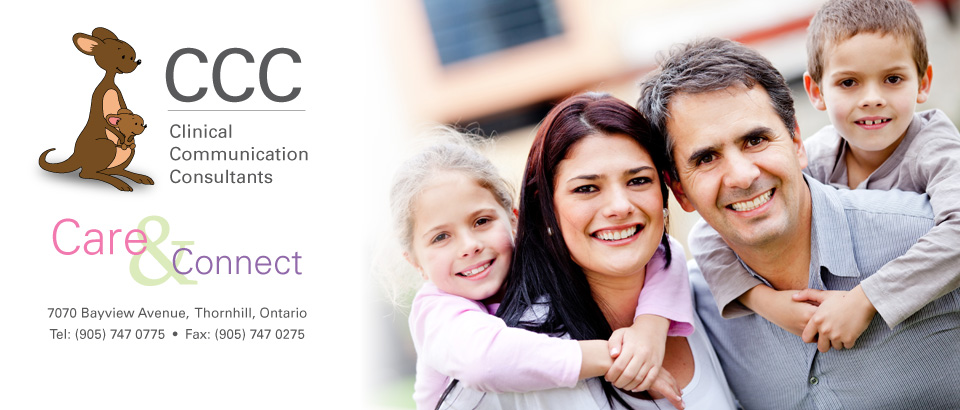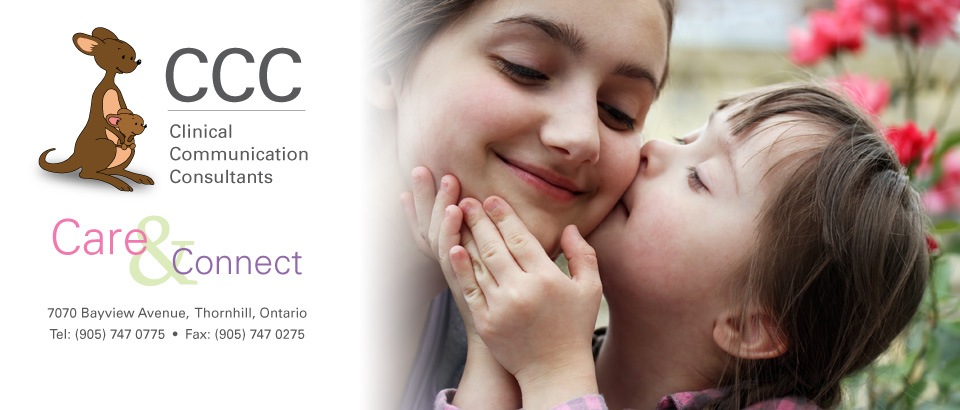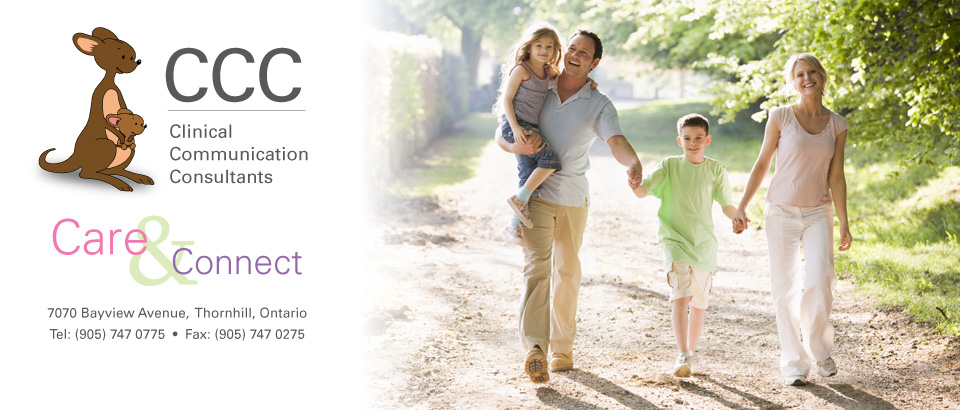Frequenctly Asked Questions
Who is a Speech-Language Pathologist?
Speech-Language Pathologists (S-LP) may assess and provide therapeutic intervention to children and adults with a variety of speech/language, voice, fluency and feeding-swallowing problems, and social interaction and communication difficulties. Some S-LPs develop expertise in certain areas over another. At Clinical Communication Consultants, S-LPs are working with the pediatric population in terms of oral-motor, speech difficulties, problems of relating and communicating as well as reflective and abstract thinking, receptive and expressive language difficulties, and cognitive-linguistic processing differences.
What kinds of speech and language disorders affect children?
Speech and language delays/disorders can affect the way children talk, understand, analyze or process information. Speech delays/disorders include voice quality, fluency and the clarity of a child's spoken words. Language delays/disorders include a child's ability to hold meaningful conversations, understand others, reflect, problem solve & self-correct or to read and comprehend, and express thoughts, feelings & experiences through spoken or written words.
At what age should I seek out help for my child?
At Clinical Communication Consultants, S-LPs work with children from early pre-school years up to adolescence. If you are concerned about your child's communication skills, please call to find out if your child should be seen for a communication evaluation and/or consultation. The early months of your baby's life are of great importance for good social skills, speech, language or emotional growth, and intelligence!
Is my child developing speech and language at a normal rate?
There are differences in the age at which an individual child understands or uses specific language skills. The following list provides information about general speech and language development. If your child is not doing 2 or 3 of the skills in a particular age range, your child may have delayed hearing, speech or language development. If your child is not doing 3 or more of the skills listed in a particular age range, please take action and contact a Speech-Language Pathologist and/or Audiologist to find out if an evaluation or consultation is necessary.
What kinds of services can I receive at Clinical Communication Consultants?
An S-LP at Clinical Communication Consultants will provide a comprehensive evaluation/assessment of your child’s speech, language, communication and social interaction skills. Your child can receive intervention services for oral-motor/speech difficulties and receptive and expressive language difficulties. The S-LPs at Clinical Communication Consultants also has extensive experience in providing therapeutic services for social-emotional interaction and communication difficulties. Additionally, computer based language and reading with comprehension training is also available.
What is the process of enrollment at Clinical Communication Consultants and is a physician's referral required?
A physician’s referral is not required to see a speech-language pathologist at our clinic.
The process generally involves:
• An initial parent intake interview
• An initial on-site formal/informal assessment with the child including observation of child-caregivers interaction
• A feedback with recommendations regarding best-suited comprehensive intervention plan, and outside referrals if deemed necessary.
How do the services offered at Clinical Communication Consultants differ from the ones offered in other agencies?
The services offered at Clinical Communication Consultants differ from the ones offered in other agencies in that they do rely heavily on a developmental relation based and integrated perspective where the DIR® model integrates the Floortime™ approach with others (such as the ABA approach or Scilearn’s computer patent training) that may be of benefit to the child’s comprehensive integrated intervention process.
What is DIR ® model?
Pioneered by Drs. Stanley Greenspan and Serena Wieder, the DIR® stands for the Developmental, Individual Differences, Relationship-based approach. It is a comprehensive, interdisciplinary approach that focuses on the social-emotional development of the child.
It takes into account the child's feelings, relationships with caregivers and his developmental levels and individual differences in regards to his ability to process and respond to sensory-motor and verbal information. It focuses on the child's skills in all developmental areas, including social-emotional functioning, sensory, verbal & non-verbal communication, thinking and learning.
The goal of intervention is to help the child master the healthy emotional milestones that were missed in his early development and that are considered as critical foundation in learning. Building these foundations helps children overcome their symptoms more effectively than simply trying to change the symptoms alone.
Resource: www.icdl.com
What is Floortime™ approach?
Floortime™, is a vital element of the DIR®/Floortime™ model. It is an intervention approach with a prescribed philosophy for interacting with children (and adults as well). Floortime™ involves meeting a child at his current developmental level, and building upon his particular set of strengths. Floortime™ harnesses the power of a child’s motivation; following his intent, wooing him with warm but persistent attempts to engage his attention and tuning in to his interests and desires in interactions. Through Floortime™, parents, child-care providers, teachers and therapists help children climb the developmental ladder. By entering into a child’s world, we can help him or her learn to relate in meaningful, spontaneous, flexible and warm ways.
A DIR®/Floortime™ clinician may prescribe a number of 20-minute Floortime™ sessions a day as part of a comprehensive intervention program. In addition, Floortime™ provides a framework that can guide various daily interactions with children; bathing, playground time, meals, etc.
Resource: www.icdl.com
What makes the DIR®/Floortime™ approach different from others?
In contrast to older models, the DIR®/Floortime™ model & approach recognizes that each child has a unique path to his or her challenges, and therefore each child’s road to improvement must also be unique. In the DIR®/Floortime™ approach, the goal of intervention is to help the child build the healthy foundations for relating, communicating and thinking. DIR®/Floortime™ clearly articulates the six basic developmental milestones that children must master for healthy emotional and intellectual growth. Mastering these healthy developmental foundations also helps children overcome their symptoms more effectively than simply trying to change the symptoms alone.
Resource: www.icdl.com
What are the components of a DIR®/Floortime™ program?
Children with special needs usually have processing differences that make it more difficult for them to master the foundations for relating, communicating and thinking that come relatively effortlessly to children without special needs. Therefore, a comprehensive intervention program needs to provide intensive opportunities to practice these skills.
Components of a DIR®/Floortime™ program include:
• Parents do Floortime™ with their child, creating the kinds of interactive experiences,opportunities that help the child master the developmental milestones.
• Professionals, such as speech-language pathologists, occupational, and physio- therapists, special educators and psychotherapists, work with the child using techniques informed by DIR®/Floortime™ principles to deal with the child’s specific challenges and facilitate development.
• Parents work on their own responses and styles of relating to their child with regard to the different developmental milestones in order to tailor their interactions with their child in a way that optimally supports emotional and intellectual growth.
Resource: www.icdl.com











